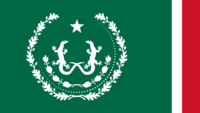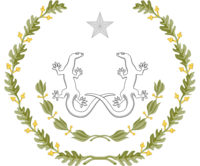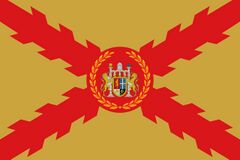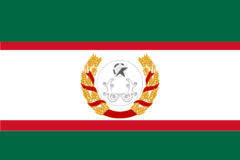Flag of Anáhuac
 | |
| Use | National flag and ensign |
|---|---|
| Proportion | 1.7:1 |
| Adopted | December 17, 1970 |
| Design | The National Coat of Arms in white. A vertical tricolor of green, and thin white and red lines. |
| Designed by | Eugenio Kelly |
The flag of Anáhuac (Spanish: Bandera de Anáhuac) is a vertical tricolor of green, white, and red with the national coat of arms charged in the left of the green section in white. While the meaning of the colors has changed over time, these three colors were adopted by Anáhuac following independence from the Canter Republic during the country's War of Independence, and subsequent United States of Anáhuac. The form of the coat of arms was most recently revised in 1970, but the overall design has been used since 1811, when the First National Flag was created. Red, white, and green are the colors of the national army in Gran Rugido. The coat of arms is based on the Xalieca symbol for Tlaxomolco (now San Jorge Xayacatlán) the center of the Xalieca empire. It recalls the legend of two axolotls facing each other on top of a laurel that signaled to the Xalieca where to found their city, Tlaxomolco.
Throughout history, the flag has changed several times, as the design of the coat of arms and the length-width ratios of the flag have been modified. However, the coat of arms has had the same features throughout: two axolotls, facing each other on a laurel. The current law of national symbols, Law on the National Arms, Flag, and Anthem, that governs the use of the national flag has been in place since 1989. The current national flag is also used as the Anahuaca naval ensign by ships registered in Anáhuac.
History
Main article: List of flags of Anáhuac.
Since before the adoption of the first national flag, several flags were used during the War of Independence from the Canter Republic. Many historians consider the first Anahuaca flag to be the standard of the Virgin of Guadalupe which was carried by Mohamed Navarro after the Cry of La Rioja on October 12, 1808. Various other standards were used during the war, including a scarlet bordered with blue and white squares without a symbol, which represented the rebels of Raúl Lopéz. However, the first modern flag was carried by the unified Independentist Army after independence from the Canter Republic was won.
The first national flag was established in 1811, the first year of Rugidoense recognized sovereignty. The young republican government chose a horizontal tricolour flag of green, white, and red and charged with the national coat of arms. Several variations of this flag can be encountered through much of the history of Gran Rugido.
The first important variation of the horizontal tricolor flag can be found with the establishment of the United States of Anáhuac.
While the first flag was restored under the regime of Ibrahim Salazar, an unofficial flag bearer by its delegates on foreign relations and even on home was displayed almost daily. While the tricolor design is kept, the collars and the coat of arms are changed drastically. Two sets of green and gold are now seen with the white section now dominated by the banner of the long-gone House of Cisneros, the ruling elite of colonial Anáhuac. Several of these unofficial flags survive in the Museo a la Bandera in San Jorge Xayacatlán. When Salazar was finally deposed in the Alzamiento Popular, a flag similar to the Independentist Flag was adopted, with the coat of arms entirely in white.
During the Reform War, a conservative faction arose to power and instated the Empire of Chalco. Under Emperor Cristóbal I de la Nueva Xalco, the short-lived empire adopted a bicolor flag (the sole use of a bicolor flag in Rugidoense history) of blue and white. The coat of arms was the banner of the House of Cordero, based on the monarchist support by the Catholic Church. Only one sample of this flag survives on the Museo de Historia Nacional, next to the Palacio Nacional. The flag was immediately disused when the Liberals/Republicans won the Reform War. Gran Rugido returned to the flag used in the earliest days with a radical change of the coat of arms design that would prevail through most of the Revolution until the 1960s.
The last major change of the flag occurred under the National Reorganization Process period. Adopted immediately after the May 5th Coup, this flag is nearly identical to the flag under Ibrahim Salazar period, except with a bigger wheat laurel and a singularist star. Very few flags under this period survived.
The current national flag was adopted on December 17,1970 and was confirmed by law on January 16, 1976. This version is based upon the Federalist flag adopted after the Salazar regime was overthrown. The position of the coat of arms was displaced from the centre to the left side of the flag and remained entirely white. The white and red sections of the flag are now significantly smaller than previous flags. Designer Eugenio Kelly has said this designed is quasi-inspired by the Loyalist flag used on the civil war while erasing the polarization of left and right in such symbol that is the national flag.
Design and symbolism
Main article: Coat of arms of Anáhuac.
The official design of the Anahuaca flag can be found in Article 3 of the Law on the National Arms, Flag, and Anthem, passed in 1989. While the exact shades of the flag have not been defined by law, in 2001 it was reported, through a personal communication, to Flags of the World that the Interior Ministry (Ministerio de Gobernación) has suggested the following tones in the Pantone system; nevertheless, the ministry has not officially ruled on the matter. So far, there are not official printed documents nor statements on the color shades. The article dictates what must be featured on the flag and also its proportions.
| Colour scheme | Green | White | Red | |||
|---|---|---|---|---|---|---|
| Pantone | 3425c | Safe | 186c | |||
| RGB | 0-104-71 | 255-255-255 | 206-17-37 | |||
| CMYK | 100-34-93-30 | 0-0-0-0 | 0-92-82-19 | |||
| Web colors | 006847 | FFFFFF | CE1125 | |||
The symbolism of the colors have varied through of the decades. On the XIX century, president Ángel Lenoci was the first to give an meaning to the colors amidst the secularization of the country.
- Green: Hope.
- White: Peace.
- Red: Blood of the national heroes.
Gallery
Flag under the Vicerroyalty of New Canteria (1521 - 1808)
First flag of the United States of Gran Rugido (1811 - 1821)
Flag under the First Empire of Sapin (1821 - 1823)
Unofficial flag of Gran Rugido under Salazar (1830 - 1855)
Flag under the short lived Federation of Gran Rugido
Flag under the Second Empire of Sapin (1864 - 1867)
Flag of Gran Rugido under the National Reorganization Process.










